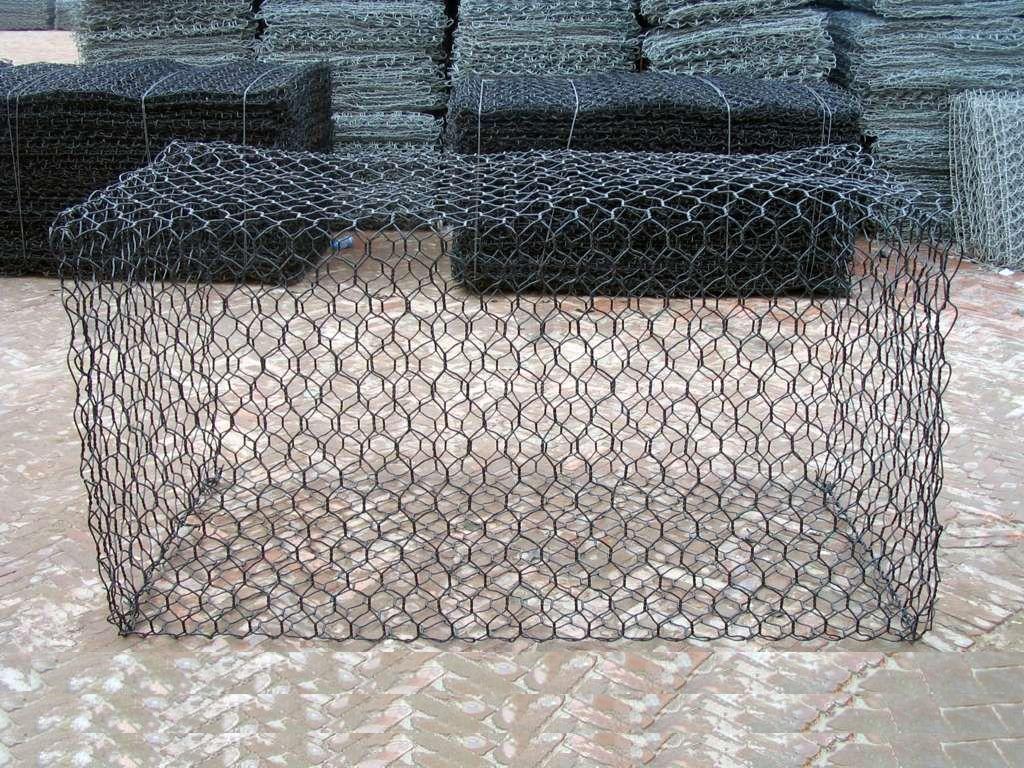
A gabion (from Italian gabbione meaning "big cage"; from Italian gabbia and Latin cavea meaning "cage") is a cage, cylinder, or box filled with rocks, concrete, or sometimes sand and soil for use in civil engineering, road building, and military applications. For erosion control, caged riprap is used. For dams or in foundation construction, cylindrical metal structures are used. In a military context, earth- or sand-filled gabions are used to protect artillery crews from enemy fire.
Civil engineeringThe most common civil engineering use of gabions is to stabilize shorelines, streambanks or slopes against erosion. Other uses include retaining walls, temporary floodwalls, silt filtration from runoff, for small or temporary/permanent dams, river training, or channel lining. They may be used to direct the force of a flow of flood water around a vulnerable structure. Gabions are also used as fish barriers on small streams.
A gabion wall is a retaining wall made of stacked stone-filled gabions tied together with wire. Gabion walls are usually battered (angled back towards the slope), or stepped back with the slope rather than stacked vertically.
Gabion baskets have some advantages over loose riprap because of their modularity and ability to be stacked in various shapes; they are also resistant to being washed away by moving water. Gabions also have advantages over more rigid structures because they can conform to ground movement, dissipate energy from flowing water, and drain freely. Their strength and effectiveness may increase with time in some cases, as silt and vegetation fill the interstitial voids and reinforce the structure. They are sometimes used to keep stones which may fall from a cutting or cliff from endangering traffic on a thoroughfare.
The life expectancy of gabions depends on the lifespan of the wire, not on the contents of the basket. The structure will fail when the wire fails. Galvanized steel wire is most common, but PVC-coated and stainless steel wire are also used. PVC-coated galvanized gabions have been estimated to survive for 60 years. Some gabion manufacturers guarantee a structural consistency of 50 years.
Gabions have also been used in building, as in the Dominus Winery in Napa Valley, California. The exterior is formed by modular wire mesh gabions containing locally quarried stone; this construction creates an environment of moderate temperatures within the building.
Variations in gabion design
There are various special designs of gabions to meet particular functional requirements and some special terms for particular forms have come into use. For example:
Bastion: a gabion lined internally with a membrane, typically of nonwoven geotextile to permit use of a granular soil fill instead of rock.
Mattress: a form of gabion with relatively small height relative to the lateral dimensions; commonly very wide. For protecting surfaces from wave erosion and similar attack, rather than building or supporting high structures.
Trapion: a form of gabion with a trapezoidal cross section, designed for stacking to give a face that is sloping rather than stepped. The term is in wide usage, but in contexts related to gabions at least, appears to be a trademark registered by Betafence Limited.
Military use
In the medieval era, gabions were round cages with open tops and bottoms, made from wickerwork and filled with earth for use as military fortifications. These early military gabions were used to protect field artillery gunners. The wickerwork cylinders were light and could be carried relatively conveniently in the ammunition train, particularly if they were made in several diameters to fit one inside another. At the site of use in the field, they could be stood on end, staked in position, and filled with soil to form an effective wall around the gun. Today, gabions are often used to protect forward operating bases (FOBs) against explosive, fragmentary, indirect fires such as mortar or artillery fire. Examples of areas within a FOB that make extensive use of gabions would be sleeping quarters, mess halls, or any place where there will be a large concentration of unprotected soldiers.
Please click the link to see the wire mesh special.
http://www.made-in-china.com/special/wire-mesh-anping-country-of-china/





